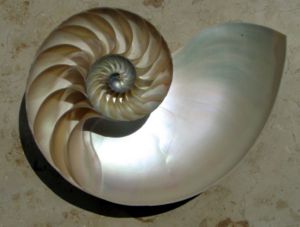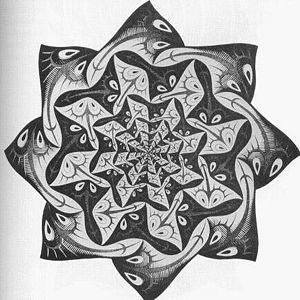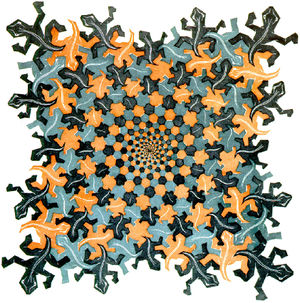Similarity Transformations

Relevant examples from Escher's work:
- Whirlpools
- Development II, Development II (First version)
- Path of Life I, Path of Life II, Path of Life III
- Aula Mural Design
- Fish, vignette (spiral)
- Butterflies (Color)
- Sketch #65 (Moths)
- Regular division of the plane by similar figures of which size and content rhythmically diminish in size, receding toward the center
Explorations
Begin learning about similarity transformations with:
More explorations related to self-similarity and iteration can be found in Fractals
Similarity
To this point, we have encountered four types of symmetry: Reflection, rotation, translation, and glide-reflection. These symmetries are rigid motions because they move a figure while preserving its size and shape. In this section, we introduce another concept that falls under the general idea of symmetry, that of similarity.

Two figures are called similar if they are the same shape but have different sizes. A similarity transformation is a rigid motion together with a rescaling. In other words, a similarity transformation may alter both position and size, but preserves shape.
| Similar Triangles |
|---|

|
Dilation
A dilation (also called a central similarity) is a rescaling along the radial lines centered at a point. The dilation factor is determined by the ratio of any length to its dilated image:
 |
 |

|
| Radial lines | Dilation by a factor of 1/3 | Dilation-rotation by a factor of 1/2 with order 4 rotation |
A dilation-rotation is a dilation combined with a rotation, and is also called spiral similarity. When describing a dilation-rotation, give a dilation factor and the order (or angle) of rotation.
A dilation-reflection combines a dilation with a reflection, and possibly rotation as well. Here, we just give the dilation amount, since the reflection line is not clearly defined.
Most of Escher's work with similarity transformations involves iteration and fractals, which we will come to in the next section. However, he does have a few lesser known pieces that are excellent examples of dilation symmetry.

Escher's 1957 Path of Life I was commissioned for a funeral building at a public cemetary in Utrecht. The design suggests the process of birth, growth, and death with a strong feeling of movement. White figures appear to emanate from the central point, reach the edge to turn black and then flow back into the singularity at the center.
In Path of Life I, there is an order 8 rotation around the center, so this is a rosette pattern with cyclic symmetry group C8. However, there is more to say. Except for the outer edge, there are only two shapes of fish (planaria?) - the white and the black. That is, all of the black fish are similar, and all of the white fish are similar. The tranformation that takes a large fish to the next smaller size is a dilation by a factor of approximately 6/10, as shown in the detail figure below:
To find the dilation factor, measure any length in one figure and the same length in the next smaller size figure. In this case, the large fish is approximately 10 units long, and the smaller fish is approximately 6 units long, so the dilation factor is approximately 6/10.

In Escher's three color woodcut Development II, the lizards lose shape and become hexagons as they approach the central point, however if we ignore that deformation then the print has a spiral similarity. Looking first for rigid motions, there is an order 4 rotation that perserves the entire print. Better, though, is to ignore the big corner lizards and consider this as a rosette pattern with C8 symmetry. Next, notice that there is a plain dilation towards the center. However, the dilation shrinks the biggest black lizards by two sizes, skipping a ring of eight. To demonstrate that all black lizards are similar, we need to recognize a dilation-rotation.
The spiral similarity of Development II is a dilation by approximately .7 with an order 16 rotation. The dilation factor comes from measuring the lizards, and the rotation has order 16 since it is half the angle of the order 8 rotation that preserves the entire print.
Escher's Fish, vignette (spiral) has an order 4 rotation, and also a central similarity. Finally, there is a dilation-reflection that transforms the black fish into the white fish and vice-versa. Typically it is hard to find the exact dilation factor of a printed image, but in this case the fish are laid out along a simple geometric scaffolding, a series of squares inscribed within each other:
Some simple geometry shows that the horizontally oriented squares decrease by a factor of 1/2 at each step, while each diagonally oriented square is the size of the next larger horizontal square. From the geometry, the dilation in Fish has a factor of exactly 1/2, and the dilation-reflection has a factor of exactly .
Find more dilations in Escher's work with the Dilation Exploration
Iteration
Another way to understand figures which contain similarity transformations is through iteration. Iteration is a process for creating figures with self-similarity, which means that a scaled copy of the figure is contained inside the original figure. All figures with dilation symmetries are self-similar.
The idea of iteration is to begin with a single motif, called the initiator and then repeatedly apply a transformation rule. Each step in the process is one iteration, numbered from 0.
Example: The initiator is a square, and the transformation rule is a dilation-rotation, scaling by a factor of towards the center of the square with a 45° rotation. The first iterations are shown below:
| Iteration #0 (the initiator) |
Iteration #1 | Iteration #2 | Iteration #3 | ... | Limit |
 |
 |
 |
 |
... | 
|
Continuing to iterate forever produces the limit picture, the square pattern described in the section on Dilations.
Example: The initiator is a square, and the transformation rule is a dilation-rotation, scaling by a factor of 1/2 and rotating by 45° around the dot in the corner of the square. The first iterations are shown below:
| Iteration #0 (the initiator) |
Iteration #1 | Iteration #2 | Iteration #3 | ... | Limit |
 |
 |
 |
 |
... | 
|
The limit of the process is a figure with spiral similarity.
Iterations are most interesting when there is more than one rule to apply. At each step, multiple new motifs are created. The next step must apply each rule to each new motif, and so the number of motifs will grow (exponentially).
Example: The initiator is a circle and there are two transformation rules. The first is a dilation by 1/2 towards the upper left, the second is a dilation by 1/2 towards the upper right. At each iteration, both transformations are applied to the entire picture.
| Iteration #0 (the initiator) |
Iteration #1 | Iteration #2 | Iteration #3 | ... | Limit |
 |
 |
 |
 |
... | 
|
An iterative process need not be mathematically precise.
Example: Each season, Stephen Colbert has a new portrait of himself painted and displayed on The Colbert Report. In each pose, he stands in front of the previous portrait, so the transformation is to paint the old portrait within the new. Iterations two, three and six are shown.
| Iteration #2 | Iteration #3 | ... | Iteration #6 | |
 |
 |
... |  |
Practice iterations with Iteration Exploration.
Exercises
Related Sites
- Spiral Tilings at Geometry Junkyard.
- Spirals and The Golden Section, by John Sharp.



